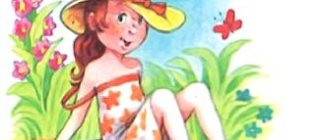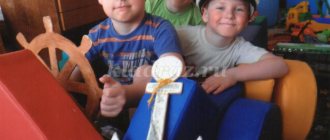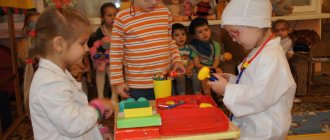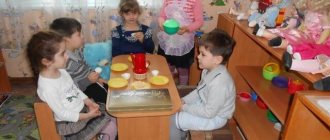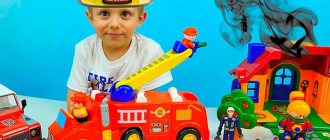Summary of the role-playing game “Bus trip to the zoo”
Summary of the role-playing game “A trip by bus to the zoo” in the senior group.
Target:
systematize children’s existing knowledge and skills about the rules of safe behavior in public places based on the role-playing game “Traveling by Bus to the Zoo.”
Tasks:
continue to develop in children the ability to perform game actions in accordance with the game plan; activate dialogic speech; encourage initiative and independence, strengthen friendly relationships during gaming activities.
Preliminary work:
a series of lessons from the “Safety” series; examination of illustrations on the topic: “Traffic rules”, “Modes of transport”, “Zoo”, “Animals of forests”, “Animals of hot countries”; reading fiction (stories, poems, riddles) S. Marshak “Zoo”, “Children in a Cage”; L. Shevchenko “At the Zoo”; K. Chukovsky “Aibolit”; didactic games: “Attention on the roads”, “Road signs”, “Safe walks”, “Who lives where?”, “Such different animals”, “Zoological lotto”; production of albums “Transport”, “Animals of hot countries”, “Animals of forests”; acquaintance with illustrations by S. Nikolaeva and N. Meshkova from the series “The World Around Us. Beasts"; conversations with children about visiting the zoo in the summer with their parents, about the professions of people working in the zoo; conversations about the characteristics of the animal world and other climatic zones.
Vocabulary work:
freight transport, passenger transport, conductor, driver; veterinarian, zoo, aviary, cashier.
Roles:
bus driver, conductor, cashier, “please”, “thank you”.
Subject-spatial environment:
toys - animals (at least 16 pieces), a designer to build enclosures, a model of a bus, a steering wheel for the driver, a conductor's bag, a model of a ticket office, tickets for the bus and to the zoo, "money".
Methods and techniques:
explanations, story, questions, playing out roles and game situations, riddles, the didactic game “Guess what sign”, the sedentary game “At the Bear in the Forest”.
Progress of the game
A teacher stands at the window with children
-November-late autumn has arrived. It’s very cold outside and everything in nature is preparing for winter. And I would really like to visit a place where you can see forest animals and animals of hot countries, regardless of the weather.
The children suggest going to the zoo. The teacher supports the children's initiative. Everyone together begins to build enclosures from the construction set and place animals (toys) in them, and set up a model of the cash register.
-How can you get to the zoo, maybe by car? (children, he is too small for us)
-But then on a truck? (Children trucks transport goods, not people)
Role-playing game "Zoo"
Story-role-playing game “ZOO”
TARGET:
Ensure children's interest in role-playing games and help create a play environment.
Educational objective:
- contribute to the expansion of knowledge about animals, their appearance, characterize them from memory
- help children learn the new profession of “veterinarian”
- to develop in children the ability to creatively develop the plot of the game using building floor material, and to act with it in a variety of ways.
Developmental task:
- develop speech, enrich vocabulary, consolidate sound pronunciation
- consolidate children's knowledge of the names of the cubs of different animal mothers.
Educational task:
- fostering a kind attitude towards animals, love for them, care for them
- cultivate friendly relationships in the game.
Preliminary work:
- Talk about animals using zoo illustrations
- viewing the album “wild animals”
- making and guessing riddles about animals
- reading fiction about animals
- depiction of animals with stencils, in visual arts (sculpting, drawing, applique)
Material:
- telephone
- building material (large, small)
- Lego "
- set of animals
- truck with cage
- white coat for doctor
- thermometer
- phonendoscope
- first aid kit
- cash register
- cards with a picture of a circle, a red spot
- arm band for controller
- tickets are halves of the didactic game “Whose Mother”
— cut-out pictures (fruits, vegetables)
Vocabulary work:
- veterinary hospital, elephant - baby elephant
- veterinarian, tiger - tiger cub
- mini-zoo, lion - lion cub
- cashier, bear - teddy bear
- controller, giraffe - baby giraffe
- aviary, zebra - foal
hippopotamus - hippopotamus,
monkey - monkey,
Methodical techniques:
- surprise moment
- problematic - game situation
- conversation
- poetry
- stories
- puzzles
- didactic, educational games
Didactic game:
- "Find Mom"
Educational game:
- "Collect a picture"
Working with parents:
- In your free time, visit the zoo with your child
- watching cartoons at home
- reading encyclopedias of the Animal World
Method. literature:
- Smolentseva A.A. “Plot-based didactic game with mathematical content”
- Vinogradova N.A., Pozdnyakova N.V. “Plot-role-playing games for older preschoolers”
- Shalaeva. G., "Encyclopedia for children"
.
- Collection about the life of wild nature “Your funny animal friends”
.
Example game actions:
- part: organizational part;
- part: problem situation;
- part: veterinary hospital;
- part: animal meeting;
- part: animal inspection (vet)
;
- part: riddles about animals;
- part: buying tickets (cashier)
;
- part: ticket checking (controller)
;
- part: conversation about animals (guide)
;
- part: treats for animals;
- part: summary.
Progress of classes:
V. — Guys, let’s stand in a circle and play the game “In the Animal World.”
V. - I have a ball, we will pass it to each other in a circle, and the one who gets it must name some animal.
(A didactic game is being played).
V. - You remembered many different animals. Well done! Where can you see them?
D. — There are pictures or photographs of animals in the books
V. - But you can see live animals and birds in the zoo. How many of you have been to the zoo?
D. -Y.
V. - Listen to this word - “zoo”. In a foreign language, the word “zoo” means “animal,” and the word “park” is well known to all of you. What do you get if you combine these words?
D. - A park where animals live.
— I suggest you make a mini-zoo, what does that mean? (small)
.
— Who takes care of the animals in the zoo? (Human)
.
- What else does he do? (protects, protects)
.
- What can we make a zoo out of? (from large building material)
.
- What should we do to prevent the animals from running away? (aviaries)
.
— And we will build enclosures (from Lego )
.
— How many enclosures need to be made? (8)
.
- Why? (because there are 8 animals)
.
Q - Guys, what kind of structures will we build?
D- cages (aviaries), veterinary hospital, entrance, cash desk.
Q - Let's first look at the diagram of how we will build the entrance to the zoo. Count how many cubes we need on both sides?
D- 4 cubes on 2 sides.
V- that's right. Now let's build an entrance according to the diagram
D- (building entrance)
B- Now let’s build a cash register. Let's count how many cubes we need?
We will need 2 cubes in 3 rows. How many cubes are there at the top and bottom?
D- There are 3 cubes on the top and 3 cubes on the bottom.
B- Well done! So we made a cash register for you. All that remains is to build a veterinary hospital. Tell me, who works at the veterinary hospital?
D - veterinarian. He examines, treats, and vaccinates animals.
Well done. Now let's look at the diagram. How many cubes will we need?
D - 3 cubes side by side.
Well done. Let's build it now.
Guys, we need to build more cages or enclosures for the animals. We will build them from small cubes.
Guys, our zoo is ready! A very beautiful zoo. Large and spacious. The animals will be brought soon. Let us sort out who wants to be a cashier, a veterinarian and an animal caretaker?
B- And here they are bringing the animals.
- Let's see what animals came to us? (children list)
.
- How can you call them in one word? (wild animals)
.
Part 5: (examination of animals by the “veterinarian” )
.
— But before we place the animals in enclosures, they must be examined by a veterinarian (the teacher appoints a child veterinarian, he examines and listens to each animal)
.
- Well (v-l addresses the child - the veterinarian)
All our animals are healthy
(yes)
.
“Then we will move all the animals into your spacious, beautiful enclosures.” But now I will tell you riddles, and whoever guesses will take exactly the animal he guesses. And will place him in his enclosure (
v-l makes riddles about animals).
Part 6: (riddles about animals)
.
They jump briskly through the trees, They fool everyone at the zoo, They only see flaws in others, And their name is... (monkeys)
.
There is a lot of power in him,
He is almost as tall as a house,
He has a huge nose
As if the nose grew 1000 years old. (elephant) .
A carcass emerges from the water. Oh, and it’s hard on land! The belly hangs to the ground, It’s fat... (hippopotamus)
All my life
I wear a vest
But without boots and without a cap . (zebra)
There is a mane, but there are no horses, There is no crown, but he is a king . (a lion)
He walks with his head up,
Not because he’s an important count,
Not because of a proud disposition.
But because he (giraffe )
.
Everyone says that I look like my dad - So clumsy, So club-footed,
But only dad is like me - he’s a fish hunter like me . (Brown bear) .
Sharp teeth, he has no time for games, Striped and menacing (Tiger )
7 part "cashier" )
;
— The zoo was built, the animals were settled. Do you want to go to the zoo, on an excursion? (Yes)
.Before you go to the zoo, let’s remember the rules of behavior at the zoo:
You can't make noise;
You cannot tease animals;
You can't feed animals
You cannot put your hands into the cage.
- But what do you need to buy first in order to get there? (tickets)
.
- Where can you buy them ? (at the register) .
- Who will sell them to you? (cashier )
- And today he will be our cashier (V-l appoints a child)
,
Part 8: (checking “controller” )
;
- But we also need a controller to make sure everyone buys tickets. (the lord appoints, he checks the controller’s child)
.
- Well, everyone bought the tickets, and the controller checked them. Now you can go to the zoo.
Part 9: (conversation about animals “excursion” )
;
— Ariela, who lives in your enclosure? Giraffe
1. Ariela:
The giraffe
is the tallest animal on Earth. Its color is light yellow with black spots. The location and size of the spots are not repeated. They feed on plants, branches and leaves of trees. The giraffe's neck is long and flexible, it has two horns on its head, and a short brown mane grows on its neck. If he wants to drink water from the ground, he needs to spread his legs wide apart to reach it. The coloring of its skin makes it virtually invisible when it feeds in the shade of trees. He has sharp eyesight and keen hearing. When a giraffe is attacked, it kicks with its hind legs or uses its head as a sledgehammer. Even a lion, when hunting a giraffe, shows caution, always approaching it from behind! A female giraffe gives birth to 1 calf with small horns.
Educator: Let's continue our journey through the zoo. Let's go visit the elephant.
2.Ralina:
The elephant is
one of the largest animals. Elephants have excellent hearing. And in hot weather they use their ears as fans. Elephants have good eyesight, long eyelashes protect the animal’s eyes from dust. Elephants use them to dig up roots. Elephants eat grass, tree bark, shoots, leaves, roots, and fruits. Elephants need a trunk to drink water from the river, tear leaves from tall trees and put them in their mouths, lift and carry heavy logs, pour water on themselves, spank a naughty elephant calf. The legs are powerful and thick. The skin is wrinkled, in folds. A female elephant gives birth to 1 calf...
3. Yaroslav: Monkey.
They have long hair. They love fruits, honey, tree bark, mushrooms, insects, and small animals. The arms are very long - twice as long as the legs. Animals move by swinging and jumping on tree branches. The monkey walks on the ground, leaning on its feet and knuckles. They can grasp tree branches with their feet.
4.N.Islam: Leo
– the lion makes a roar or growl. He sleeps during the day and hunts at night. Lions mainly feed on zebras, gazelles, and antelopes. Sometimes they attack giraffes, but never touch elephants, rhinoceroses, or hippos.
5.Rinal:Zebra
– This is an elegant, playful striped horse. She has excellent memory and good eyesight. Each zebra has a unique pattern of black and white stripes, similar to human fingerprints. The pattern of zebra stripes is never repeated. Foals find their mothers using this trait. In fact, a zebra is black with white stripes, and not vice versa, as some people believe. They live in herds. It feeds mainly on grasses and sedges. A zebra gives birth to 1 foal.
6.P.Diana.TIGER
- the largest cat in the world, flexible, mustachioed, striped fur. He is very strong and dangerous. It feeds on animal meat. The strength in its paws is great - it can overwhelm a bull. There is no time to play with this beast, the tiger is very dangerous.
7.G.Diana: Hippopotamus
- this is
a “water horse ”
. It can walk along the bottom and collect succulent aquatic plants, which it readily feeds on. Hippos usually feed at night and rest during the day. It can stay under water for 8-9 minutes.
8. Gulnaz: Brown Bear
–
Bears live in the taiga, sleep in a den in winter, love honey, berries Part 10: (treat for animals)
;
- Our animals are hungry, we need to feed them.
—What do animals like to eat? (children's answer)
.
— I suggest you go to the table and prepare a treat from cut-out pictures
Part 11: (result)
.
— Did you like the game at the zoo?
— Which animals piqued your interest?
-Which role turned out to be the most interesting?
— Why can’t you have wild animals in your apartment?
Educator: guys, there’s some kind of chest here, let’s open it and see what’s in the chest? (cookies in the shape of animals). This is from the residents of the zoo. They say thank you for visiting us.
With the song “Zoo” (music and lyrics by I. Liberov)
